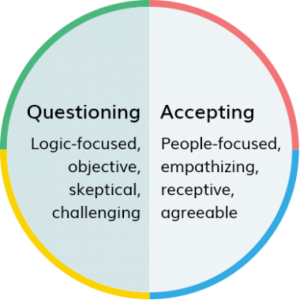Build the room
Introducing the 4 DiSC styles
Objectives: Introduce the DiSC styles and people-reading. Get people moving about in physical space or virtually.
This exercise can be done before delivering an Everything DiSC® assessment or before providing learners with their profiles.
Prerequisites: None
Materials: Signage to indicate where people should stand can be helpful in a physical space. You can label each space with D, i, S, and C, or with more descriptive words. A shared whiteboard or other virtual space is useful for online participants.
Time required: ~30 minutes
Instructions:
Tell your learners that you're going to do a very quick assembly of the group into four styles. This will be based on simple commonalities and differences. Remind everyone that there are no value judgments involved and that these are very rough estimations of your styles.
First you'll group by one's pace. This is one difference among people that's fairly easy to spot. Ask “Are you more fast-paced, active, assertive, and outspoken; or are you more cautious, reflective, thoughtful, and methodical?” Ask the more active to move towards the north (or front) and the more thoughtful to move to the south (or back).

Ask learners to notice who is in their group. If time allows, you can also ask for a few volunteers to give an example of how they have exhibited this trait.
Next we'll look at agreeability. Ask “Are you more questioning, skeptical, objective, and challenging; or are you more accepting, warm, empathizing, and people-focused?” Tell learners to now move towards the east (or left) if they are more questioning and to the west (or right) if they are more accepting.

Ask learners to notice who is in their group now. If time allows, ask for a few volunteers to give an example of how they have exhibited this trait.
If doing this activity virtually, you can have people put their initials on a white board in the area you indicate. Or you can assign a different reaction symbol to each group. Or, you can ask each group to hold up a different common item, such as a cup or mug for one group, a pen or pencil for another, a piece of paper for the third, and a book or phone for the fourth.
Let everyone know that you want the fast-paced/outspoken and questioning/skeptical people to assemble in the northwest. Explain that these are those who expect to see DiSC results with higher D-style results. They are the more active, assertive, dynamic, direct, strong-willed, forceful, and bold members of this group.
To the northeast should be the people who identify as more fast-paced/outspoken and accepting/warm. These are the i-style people. They can be described as more people-focused, empathizing, receptive, sociable, talkative, lively, and agreeable.
The more cautious/reflective and accepting/warm people should now be in the southeast. They are those with stronger S styles. They will be seen as more moderate-paced, calm, methodical, gentle, accommodating, soft-hearted, and thoughtful.
The people with stronger C styles will be in the remaining southwest quadrant. They identify more with being logical, objective, reserved, private, analytical, systematic, and challenging.
You've now built the room into the four main DiSC styles. This DiSC model provides a common language that people can use to discuss what behaviors they share with others, and what they do differently.
Explain to your learners that, of course, there's much more depth and subtlety to be found in everyone's DiSC profile. Some learners probably feel like these descriptions fit them very well and others less so. This intensity or strength of inclination toward one's DiSC style is reflected in their own individualized profiles.
Also inform learners that we're all a combination of these styles. For example, sometimes someone who is more focused on action and results will need to shift and be more patient, supportive, or methodical. It'll just take more effort or practice.

